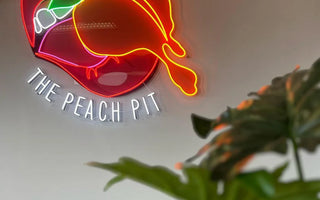Neon lighting has made its mark on design history and continues to influence the way businesses use light to attract attention. From its early industrial applications to its adoption as a symbol of modernity and art, neon has come a long way.
In this article, we'll explore the history of neon design , its importance, and why understanding this evolution can benefit your business.

Origins of Neon: The Birth of a Lighting Revolution
The history of neon begins in the early 20th century with the discovery of neon gas by British chemist William Ramsay in 1898. However, it was French physicist Georges Claude who is credited with inventing the first neon signs in 1910. Using tubes filled with neon gas, Claude was able to produce a bright red light, paving the way for a whole new form of street lighting.
Global Expansion: Neon Conquers the Streets
In the 1920s, neon signs began to spread throughout major European and American cities. Paris was one of the first cities to massively adopt this new technology, hence its nickname “City of Lights”. At this time, neon was used for illuminated commercial signs , revolutionizing street advertising.
The Golden Age of Neon: An Iconic Design
The 1950s and 1960s marked the golden age of neon design, particularly in the United States, where cities like Las Vegas and New York became famous for their spectacular neon signs. Businesses used illuminated signs to attract customers and stand out in an increasingly competitive business environment.
The Evolution of Neon Style
Over the decades, neon has evolved not only in its shapes and colors, but also in its artistic uses. From simple classic signs to creative and complex designs, neon has evolved from a simple advertising medium to a true art form . Artists like Bruce Nauman have used neon to create iconic works of art, highlighting its aesthetic potential.
The renaissance of neon in the 2000s
After a brief period of decline in the 1980s with the emergence of LED technologies, neon experienced a renaissance in the 2000s. Businesses and designers are rediscovering its unique power of attraction. Today, neon has become a symbol of modernity , used in boutiques, cafes, and even for events like weddings or art exhibitions.
LED Neon: A sustainable innovation
The development of LED neon has made this technology even more attractive to businesses. In addition to the design flexibility offered by traditional neon, LED versions are more energy efficient and easier to maintain, while still maintaining that powerful visual effect.
To learn more about the latest innovations in neon lighting, check out this article on modern lighting technologies .

Why is the history of neon design important for business?
Understanding the history of neon design allows businesses to use this technology more strategically. Neon isn’t just lighting; it’s a cultural symbol that evokes elegance, nostalgia, and modernity all at once. Using a neon sign in your store or business can create an emotional connection with customers, and strengthen your brand image.
The Benefits of Neon Signs for Businesses
- Increased Visibility : Neon is great for attracting attention, especially at night. A well-designed neon sign can transform your storefront into a must-see visual landmark.
- Customization : With a wide variety of colors and shapes, neon signs can be fully customized to reflect your brand identity.
- Durability : New neon technologies are robust, offering a long lifespan, while being energy efficient , making them an excellent long-term investment.
For more tips on using neon signs for your business, check out this article on creative signage .
Neon, a source of inspiration for modern businesses
Neon design has undergone over a century of transformation, going from a simple technical innovation to a true form of artistic expression. Today, its use allows companies to benefit from its ability to capture attention and create a strong visual identity . By exploiting the legacy of neon, you can add a touch of modernity and originality to your brand.
























